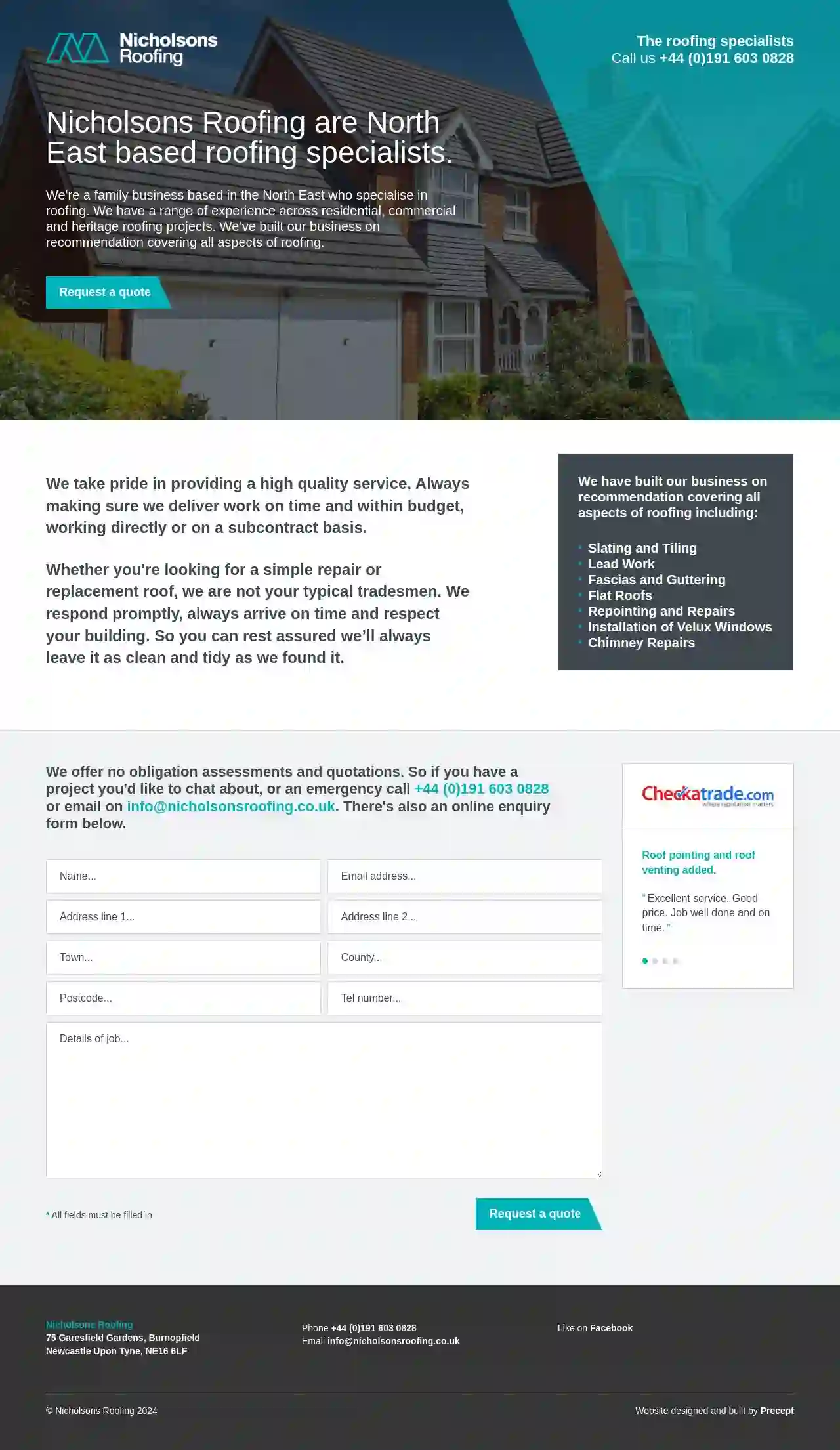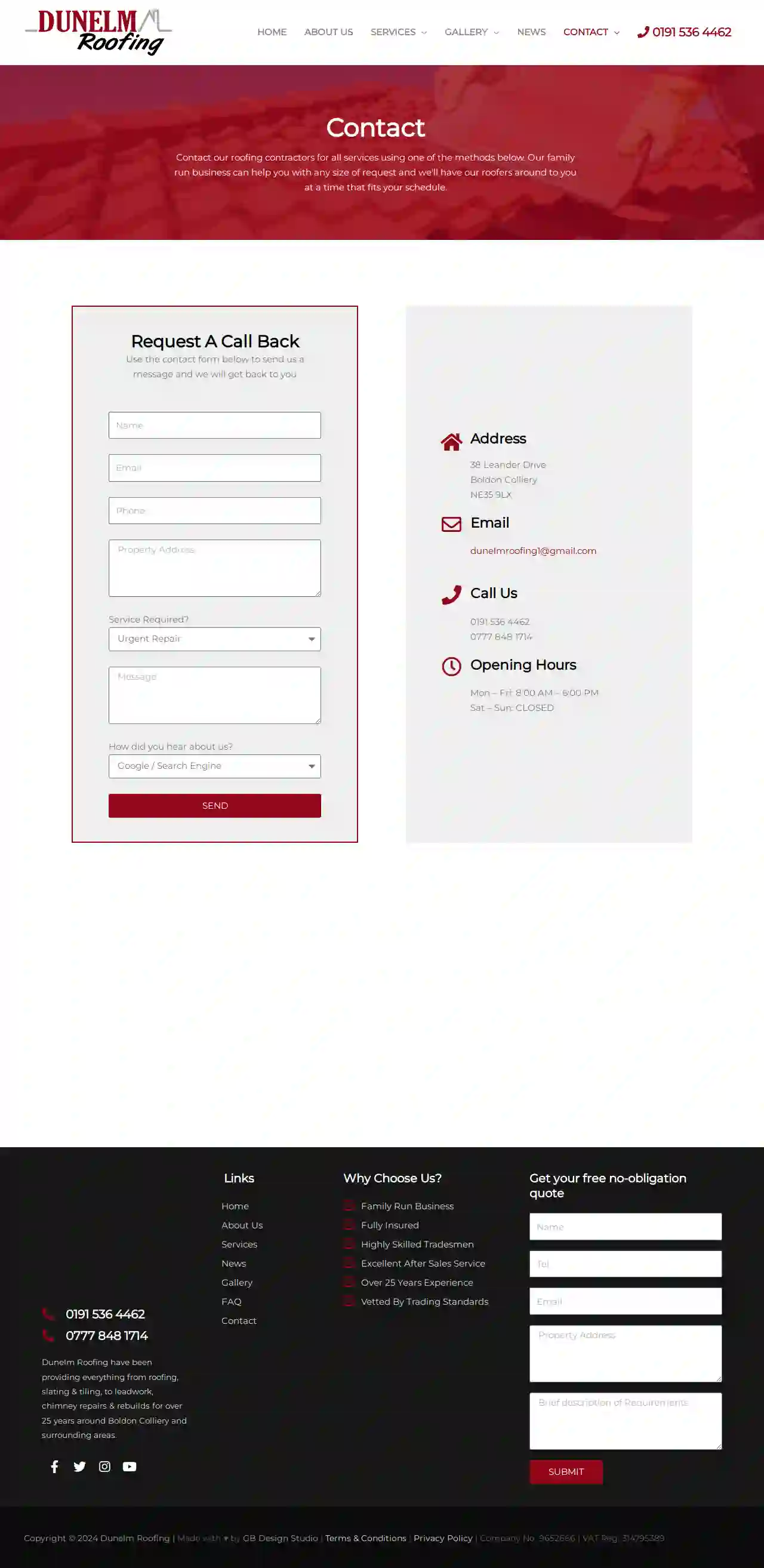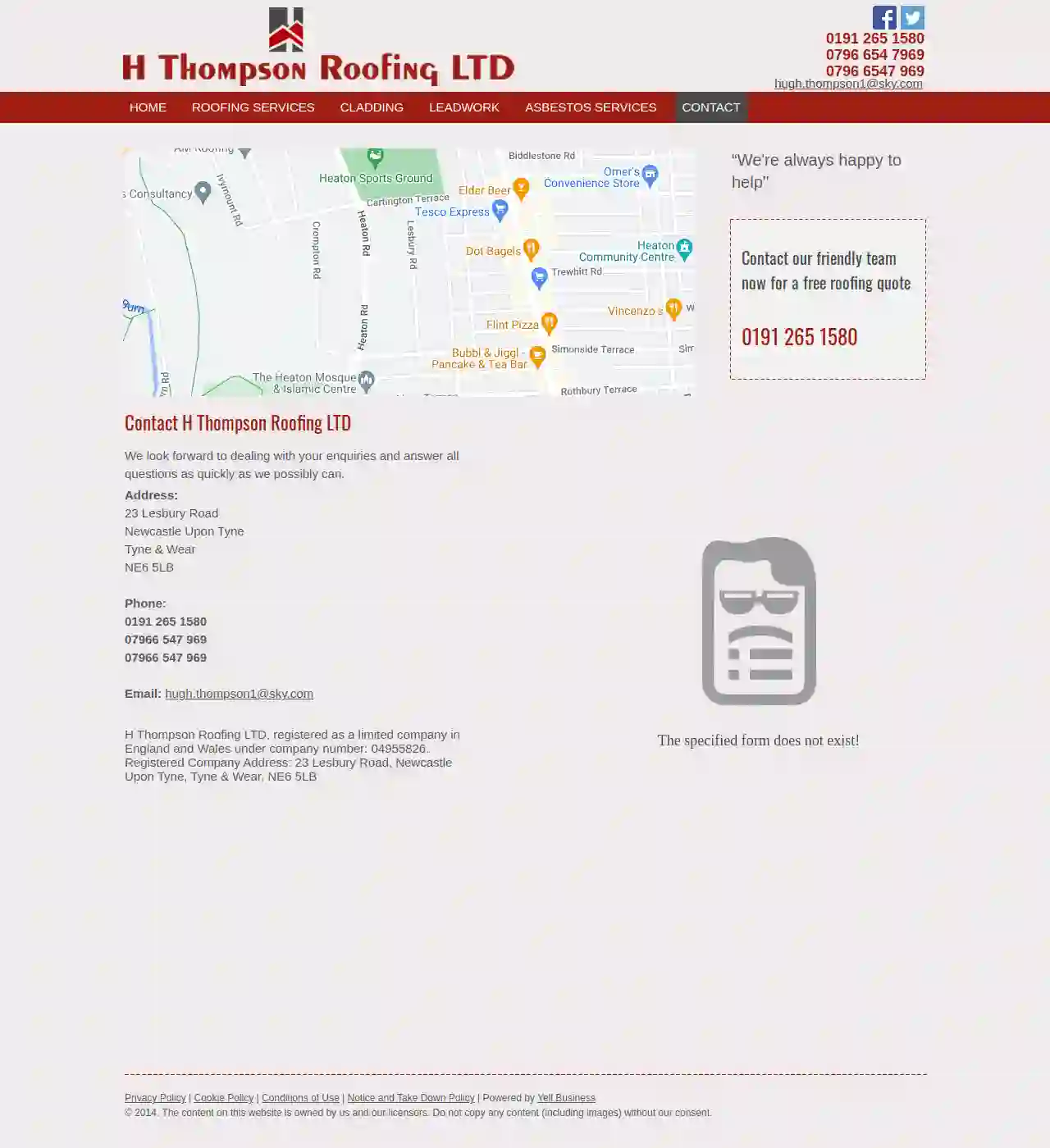Roofing Companies Rowlands Gill
Top 10 Roofing Service in Rowlands Gill
Get 3 FREE Roofing Companies quotes for your project today! Compare profiles, reviews, accreditations, portfolio, etc... and choose the best service.

Five star Roofing north east
52 reviewsGBFive Star Roofing is a family-run business based in County Durham, specializing in expert roofing solutions for both commercial and domestic properties in the North East of England. With over 18 years of experience, they pride themselves on providing a speedy and reliable service, always aiming to repair roofs before resorting to full replacement to save customers money. They offer a 10-year guarantee on all their services, ensuring peace of mind for their clients. Their team of experts is dedicated to delivering high-quality workmanship and excellent customer service, as evidenced by their consistently positive five-star reviews.
- Services
- Why Us?
- Our Team
- Testimonials
- Gallery
Get Quote
Briggs Amasco Ltd
Newcastle, GBBriggsAmasco is UK’s leading national commercial roofing company. Roofing your World Since 1865. Our Mission is to carry out Roofing and Waterproofing contracts, using the best and technically most appropriate products in order to give our customers the best value in accordance with their budgetary and performance requirements.
- Services
- Why Us?
- Gallery
Get Quote
J & L Welch Roofing & Paving services LTD
4.817 reviewsGBJ & L WELCH ROOFING & PAVING SERVICES LTD is a family run business with over 20 years experience in the roofing and paving industry. We pride ourselves on providing a high quality service at a competitive price. We cover all aspects of roofing and paving, from small repairs to full roof replacements. We also offer a range of other services, such as chimney stack repairs, dry ridge and verge systems, and flat roof installations. We are fully insured and accredited, and we always use the highest quality materials. We are committed to providing our customers with a stress-free experience, from start to finish. If you are looking for a reliable and experienced roofing and paving company, look no further than J & L WELCH ROOFING & PAVING SERVICES LTD.
- Services
- Why Us?
- Accreditations
- Our Team
- Testimonials
- Gallery
Get Quote
Marshalls Roofing Contractors
11 reviewsUnit 1, The Old Mill, Morpeth, Northumberland, NE61 3AA, GBNorthumberland Roofing Network is a network of trusted roofing professionals serving the Northumberland area. We offer a wide range of roofing services for both residential and commercial properties, including roof repairs, flat roofing, pitched roofing, fascias and soffits, and more. Our members are highly skilled and experienced in all aspects of roofing, and they are committed to providing high-quality workmanship and excellent customer service. We understand that your roof is a vital part of your home or business, and we are dedicated to ensuring that it is properly protected. Whether you need a small repair or a complete roof replacement, our members can help. Contact us today for a free quote.
- Services
- Why Us?
- Gallery
Get Quote
Turnbull Roofing
52 reviewsUnit 10, The Business Centre, Newton Aycliffe, County Durham Roofing Network, DH1 1AA, GBCounty Durham Roofing Network is a network of trusted roofing professionals serving County Durham and surrounding areas. We offer a wide range of roofing services for both residential and commercial properties, including roof repairs, flat roofing, pitched roofing, fascias and soffits, and more. Our members are highly skilled and experienced in all aspects of roofing, ensuring that your roof is in safe hands. We understand the importance of a well-built roof, and we are committed to providing our clients with high-quality workmanship and exceptional customer service. Whether you need a small repair or a complete roof replacement, our team can help. Contact us today for a free quote and let us take care of your roofing needs.
- Services
- Why Us?
- Gallery
Get Quote
Endura Flat Roofing Ltd
548 reviewsNewcastle, GBNEWCASTLE’S EXPERT, PROFESSIONAL, HIGHLY RECOMMENDED RUBBER FLAT ROOFING SERVICE Superior Quality, Longer Lasting, EPDM Rubber Flat Roofers in Newcastle upon Tyne and across the North East QUALITY SERVICEPEACE OF MIND GET A QUOTE → CALL: 0191 2363008 “ I felt that I was in safe hands with people who cared about their work. I would have no hesitation in wholeheartedly recommending Endura Flat Roofing Ltd .”Ruth Draper - Garage & Bay Window Rubber Roof in Heaton, Newcastle. GET A QUOTE → “…the most professional team we have come across whilst carrying out building work. I would highly recommend Endura Flat Roofing Ltd”Mike Ions - Garage, Porch, Rear Extension and Dormer Flat Roofs Replaced, Ponteland - Newcastle upon Tyne. GET A QUOTE → Reliable Flat Roofing Services covering Newcastle & The North East: Garage Flat Roofs: Our EPDM Rubber Flat Roofing system is the perfect system for your garage flat roof. It is the only system that can cover the whole roof in a single sheet - no joints, no seams = NO LEAKS. There is simply no better flat roof membrane for garage roof replacement. GET A QUOTE → CALL: 0191 2363008 Bay Window Flat Roofs: Bay Window Flat Roofs tend to get forgotten until they leak. With our longest lasting EPDM rubber roofing technology you can forget your bay window flat roof for a very long time once you’ve had it replaced by us. 25yr membrane guarantee and a 50yr lifespan. Do it once, Do it right. GET A QUOTE → CALL: 0191 2363008 Flat Roof Repairs: Like everything we do we go the extra mile with our flat roof repairs. We use a tried and tested liquid repair system in combination with re-enforcing scrim and a final protective coating of mineral slate chippings which dramatically increases the service life of the flat roof repair. GET A QUOTE → CALL: 0191 2363008 Insulated Flat Roofs: We have become the go to specialists for insulated flat roofs in the North East. Having been accredited for and participated in the Green Homes Grant Scheme we’ve probably installed more insulated flat roofs than any other contractor in the area. NFRC Competent Roofer, Passive House and Trustmark Certified we have the skills to do it right and provide the Building Control Certificate to prove it. We still have lots more services to add to the website but rest assured if it’s a flat roof we probably do it so just get in touch. GET A QUOTE → CALL: 0191 2363008
- Services
- Why Us?
- Accreditations
- Testimonials
- Gallery
Get Quote
Nicholsons Roofing
3.73 reviews75 Garesfield Gardens, Burnopfield, NE16 6LF, GBNicholsons Roofing are North East based roofing specialists. We're a family business based in the North East who specialise in roofing. We have a range of experience across residential, commercial and heritage roofing projects. We’ve built our business on recommendation covering all aspects of roofing. We take pride in providing a high quality service. Always making sure we deliver work on time and within budget, working directly or on a subcontract basis. Whether you're looking for a simple repair or replacement roof, we are not your typical tradesmen. We respond promptly, always arrive on time and respect your building. So you can rest assured we’ll always leave it as clean and tidy as we found it.
- Services
- Why Us?
- Testimonials
- Gallery
Get Quote
Dunelm Roofing
51 reviews38 Leander Drive, Boldon Colliery, NE35 9LX, GBDunelm Roofing is a family-run business that has been providing roofing services in Boldon Colliery and surrounding areas for over 25 years. They offer a wide range of services, including roofing, slating & tiling, leadwork, chimney repairs & rebuilds, felt roofing, rubber roofing, full re-roofs, uPVC fascias & gutters, fibreglass roofing, and Velux windows. They pride themselves on their competitive prices, excellent after-sales service, and commitment to customer satisfaction. Dunelm Roofing is fully insured and their engineers are trained and accredited.
- Services
- Why Us?
- Gallery
Get Quote
EWS Roofing Specialists
4.58 reviewsStakeford, 22 Osier Court, Northumberland, NE62 5UG, GBAt EWS Roofing Services, we offer a first class roofing service at competitive prices. We take great pride in our work and our priority is to ensure that you, the customer, are 100% SATISFIED with our work. Whether it is a single slate or tile or a re-roofing, we will always strive to ensure to always provide excellent craftsmanship at competitive rates. Whether slating or tiling no detail is too small, from the start right through till the end of the project, you are in capable hands. All our re-roofing projects are undertaken safely, securely and all debris is removed from site.
- Services
- Why Us?
- Gallery
Get Quote
H Thompson Roofing LTD
23 Lesbury Road, Newcastle Upon Tyne, NE6 5LB, GBH Thompson Roofing LTD is a family-run business with over 30 years of experience in the roofing industry. We offer a complete range of roofing services for both domestic and commercial clients, including new builds, repairs, maintenance, leadwork, cladding, and asbestos removal. We pride ourselves on our high quality workmanship, competitive prices, and excellent customer service. We are fully insured and accredited, and all of our work is guaranteed.
- Services
- Why Us?
- Accreditations
- Our Team
- Testimonials
- Gallery
Get Quote
Over 12,314+ Roofers on our platform
Our roofing pros operate in Rowlands Gill and beyond!
Roofyng.co.uk has curated and vetted Top Roofers near Rowlands Gill. Find the most trustworthy contractor today.
Frequently Asked Questions About Roofing Companies
- Leaks or Water Stains: Water stains on ceilings or walls, dripping water, or dampness in the attic.
- Missing, Cracked, or Curled Shingles: Inspect for damaged or missing shingles, especially after a storm.
- Damaged Flashing: Look for rust, corrosion, or gaps in flashing around chimneys, vents, or skylights.
- Sagging or Uneven Rooflines: A sagging roof could indicate structural problems.
- Granule Loss: Excessive granules in gutters suggest aging asphalt shingles.
- Moss or Algae Growth: Can trap moisture and damage roofing materials.
- Asphalt Shingles: 20-30 years
- Metal Roofing: 40-70 years
- Tile Roofing: 50-100 years or more (clay and slate)
- Flat Roofing: 15-30 years (depending on material)
- Slate: 100 years or more
- Wood Shakes or Shingles: 30-50 years (with proper maintenance)
- Clear the Area: Remove any vehicles, outdoor furniture, or other items from around your house to provide the roofing crew with easy access.
- Protect Landscaping: Cover plants, shrubs, and other landscaping elements near the house with tarps or plastic sheeting to protect them from falling debris.
- Clear the Attic: Remove or cover items stored in your attic, as dust and debris might fall through during the removal of the old roof.
- Notify Neighbors: It's courteous to inform your neighbors about the upcoming roof replacement project, especially if it's likely to be noisy or disruptive.
- Discuss Logistics with the Contractor: Coordinate with the roofing contractor regarding access to your property, parking arrangements, and any special instructions or concerns you have.
- Home Improvement Loans: Offered by banks or credit unions.
- Home Equity Loans or Lines of Credit: Use your home's equity as collateral.
- Government Programs: Check for energy efficiency rebates or grants.
- Contractor Financing: Some roofing companies offer financing plans.
What are some common signs of roof damage?
How long does a roof typically last?
How do I prepare for a roof replacement?
How can I get financing for a new roof?
What are some common signs of roof damage?
- Leaks or Water Stains: Water stains on ceilings or walls, dripping water, or dampness in the attic.
- Missing, Cracked, or Curled Shingles: Inspect for damaged or missing shingles, especially after a storm.
- Damaged Flashing: Look for rust, corrosion, or gaps in flashing around chimneys, vents, or skylights.
- Sagging or Uneven Rooflines: A sagging roof could indicate structural problems.
- Granule Loss: Excessive granules in gutters suggest aging asphalt shingles.
- Moss or Algae Growth: Can trap moisture and damage roofing materials.
How long does a roof typically last?
- Asphalt Shingles: 20-30 years
- Metal Roofing: 40-70 years
- Tile Roofing: 50-100 years or more (clay and slate)
- Flat Roofing: 15-30 years (depending on material)
- Slate: 100 years or more
- Wood Shakes or Shingles: 30-50 years (with proper maintenance)
How do I prepare for a roof replacement?
- Clear the Area: Remove any vehicles, outdoor furniture, or other items from around your house to provide the roofing crew with easy access.
- Protect Landscaping: Cover plants, shrubs, and other landscaping elements near the house with tarps or plastic sheeting to protect them from falling debris.
- Clear the Attic: Remove or cover items stored in your attic, as dust and debris might fall through during the removal of the old roof.
- Notify Neighbors: It's courteous to inform your neighbors about the upcoming roof replacement project, especially if it's likely to be noisy or disruptive.
- Discuss Logistics with the Contractor: Coordinate with the roofing contractor regarding access to your property, parking arrangements, and any special instructions or concerns you have.
How can I get financing for a new roof?
- Home Improvement Loans: Offered by banks or credit unions.
- Home Equity Loans or Lines of Credit: Use your home's equity as collateral.
- Government Programs: Check for energy efficiency rebates or grants.
- Contractor Financing: Some roofing companies offer financing plans.